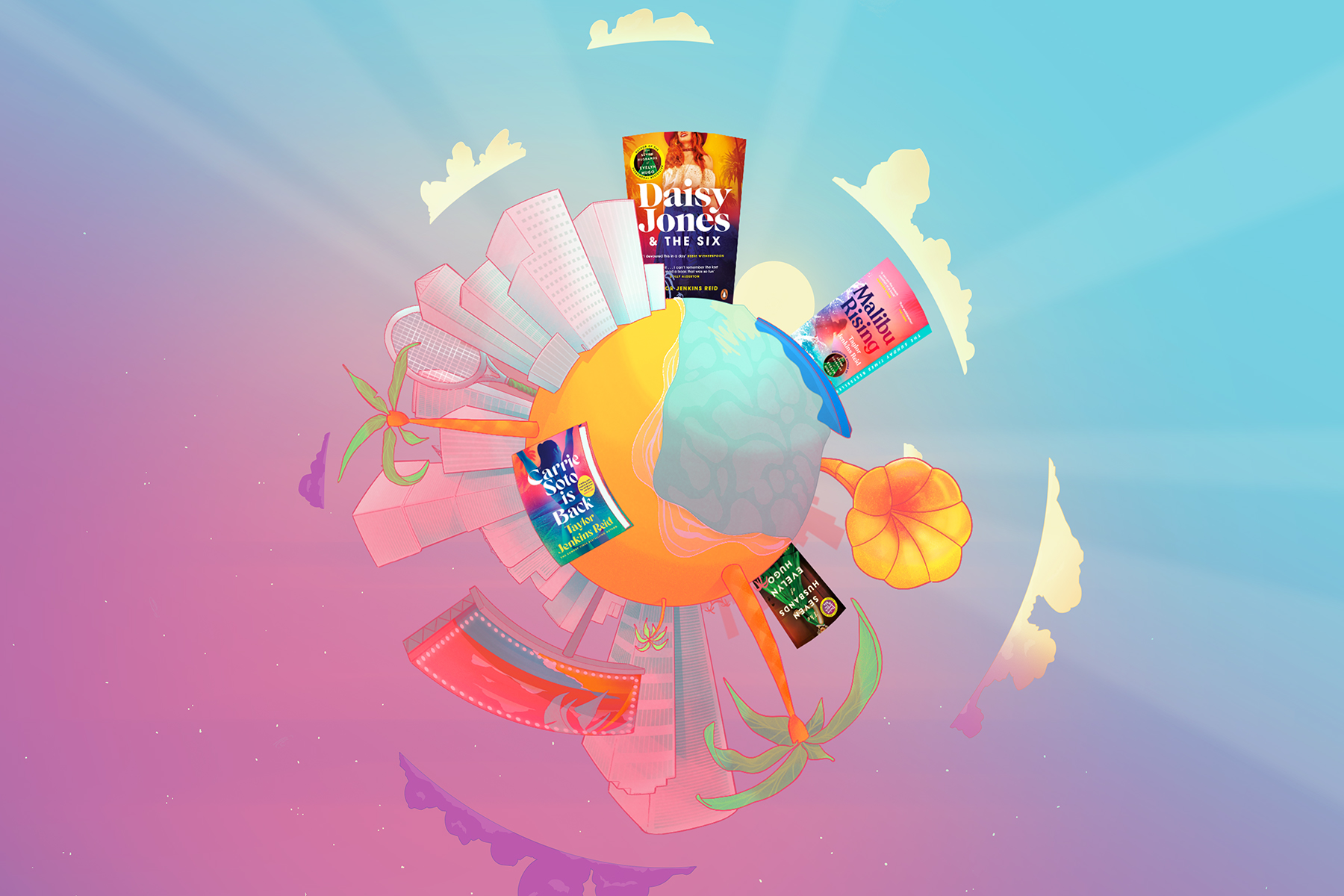
Taylor Jenkins Reid’s book universe: an explainer
Malibu Rising, Daisy Jones & The Six, The Seven Husbands of Evelyn Hugo and Carrie Soto Is Back are all interconnected: author Taylor Jenkins Reid tells us how
Warning: contains spoilers for Daisy Jones & the Six, The Seven Husbands of Evelyn Hugo and Malibu Rising
Chances are, if you’ve read one Taylor Jenkins Reid novel, you’ll probably be eager to read another. The American author is no stranger to international bestseller lists. From the Old Hollywood charm of The Seven Husbands of Evelyn Hugo to Seventies rock parable Daisy Jones & The Six, the ocean-misted Eighties of Malibu Rising and, most recently, the fierce competition of top-tier tennis in Nineties-set novel Carrie Soto Is Back, Jenkins Reid’s books cover a particularly alluring part of the 20th Century, where glamour and danger endlessly collide.
Did you know, though, that the four books exist in the same universe? “I think these four books work as a set. They don’t have to be read in any particular order but they are variations on a theme – and they work in tandem,” Jenkins Reid explains to us.
The decision to give Soto a novel of her own arrived after Jenkins Reid wrote Malibu Rising: “I was thinking of what I wanted to do next, and I realised that I already had the main character,” she tells us. “I had already created someone I knew well enough to follow on another journey. It was a real thrill to look at who Carrie Soto was in Malibu Rising and ask myself, ‘Where can I take her next?’"
Jenkins Reid’s characters, she says, “appear right at the beginning” of her process. "I don’t think I can put one word down without knowing these women and having spent a few weeks thinking about them and what they want and what they would do. My research period lasts about four to five weeks when I’m obsessed with trying to create them in my mind, to feel as if I can hear their voice. So that when I start writing, they are fully formed.”
Not only fully formed, but ready to leap into one another’s narratives. Perhaps you were intrigued to see Carrie Soto get her own novel after her incendiary appearance at Nina Riva’s party in Malibu Rising, but she’s not the only character to appear across the four novels. “There are little Easter eggs all over the place. There are a lot of people that have gone to the Riva party over the years,” says Reid. “Obviously, Mick Riva is mentioned or featured in all of them,” she adds, but there are “many, many more” connections across the book – “too many to list, perhaps”.
Nevertheless, we’ve taken a stab: here’s an entry-level breakdown of how the Taylor Jenkins Reid universe fits together.
The interconnected world of Taylor Jenkins Reid
Mick Riva: The man at the middle of it all
As Jenkins Reid says, there’s no particular order to read these four books in, but for ease and consistency we’re going to approach them in the order they were published; starting with The Seven Husbands of Evelyn Hugo (2017) before moving into Daisy Jones & The Six (2019), Malibu Rising (2021) and finally, Carrie Soto is Back (2022). Mick Riva pops up within the first pages of Evelyn Hugo, listed as narrator and journalist Monique Grant rattles through the titular heroine’s spouses: “The quickie Vegas elopement with singer Mick Riva”.
This short sentence begins a sprawling legacy across the universe. Mick marries film star Evelyn Hugo in 1961; he's two divorces down already but nevertheless a star in his own right, and one seasoned enough to navigate the necessity of a celebrity annulment. Hugo and Riva’s is a marriage of convenience: one that enables the crooner to sleep with the most beautiful woman in the world and offers Hugo a convincing beard for her own lesbian relationship. The pair have long occupied the same world, as evidenced by the mentions of Ciro’s, the celebrity Hollywood joint at which to be seen in the mid-Fifties, in both Evelyn Hugo and Malibu Rising.
Fast-forward 16 years, and Riva is next spotted in the pages of Daisy Jones & The Six, at the Chateau Marmont party where one of the most iconic ever photographs of rock star Daisy was taken – floating in a swimming pool in a caftan. As Daisy later recalled in the book: “It got later into the night and somehow Mick Riva shows up. He’d been staying at the Marmont, too. He was in his forties by then, I think. Married however many times, had like five kids. But partied like he was nineteen. He was topping the charts even then. Everybody still loved him. I’d partied with him a few times. He was always decent to me. But he was a real . . . There were always a lot of groupies with Mick. He could really get a party out of control.” Simone, friend of Daisy, would later recall that Mick was “making out with two girls that couldn’t have been more than sixteen”.
It's not until Malibu Rising that Mick Riva’s backstory comes to fruition, and if you want to meet him on the up, this is where to start. We learn that he’s the product of a broken, violent home in the Bronx who grows into an aspiring singer, “running west in search of fame”. Riva’s 23 when he walks out of the ocean to meet June Costas. He’s “undeniably handsome” with “broad shoulders” and a full bottom lip. Malibu Rising is the story of the Riva family: Mick and his four children Nina, Jay, Hud and Kit – all of whom were raised by June within reach of the Pacific Coast Highway and the crashing waves of the Pacific Ocean.
The party that exposes the family’s darkest secrets takes place at his daughter Nina’s house – which Mick accidentally burns down in 1983, causing one of the greatest Californian wildfires in history.
Malibu Rising shows us that Mick and Evelyn’s worlds collided even outside of their marriage: he had an affair with Ruby Reilly, Evelyn’s co-star in the Oscar winning adaptation of Little Women.
And yes, Mick Riva does appear in Carrie Soto Is Back, too – albeit in passing. Soto’s father and coach, Javier, mixed in fancy enough circles to have encountered Riva. His opinion is remarkably similar to that of many TJR fans: “I cannot stand that guy”.
Nina Riva: the hostess, the big sister, the love rival
When it comes to the magazine headlines (which play a consistently significant role across the universe), Nina Riva and Carrie Soto are bound together across both Carrie Soto is Back and Malibu Rising: “LOVE-LOVE: BRANDON AND CARRIE SET UP LOVE NEST AT BEVERLY HILLS HOTEL, LEAVING NINA RIVA BROKENHEARTED” is one such example, which also handily acts as a useful precis.
The gory details are all in the books – and there are plenty – but whichever one you read first you’ll get a new perspective. As Jenkins Reid told us: “knowing what Carrie Soto did back in 1983 shades how you see her in 1995. Knowing her in 1995 will shade what you think of what she does in 1983.” As for the man they’re fighting over, Brandon? His choice of getaway car from the torrid scene in Malibu Rising belonged to none other than Mick Riva.
The hacks that document everything
An interesting – and easily overlooked – skein to these books is how Jenkins Reid represents the media. In Carrie Soto Is Back, the reader is offered different perspectives of the tennis pro’s career: not just from Carrie herself, but from the relentless interest of the media. Daisy Jones & The Six borrows from the oral history format more often seen in entertainment reportage than novels, and Evelyn Hugo begins with a news story setting the scene in The New York Tribune, a structural device that plays out across the decades captured by Evelyn’s memories.
Eagle-eyed readers will notice, though, that the media outlets remain the same throughout the books. For instance Vivant magazine, to which Evelyn Hugo offers to sell her story, is also the magazine that transforms Nina Riva’s career, when a photographer offers to take her photo while she’s surfing. It’s also, later, the magazine that supports Carrie’s comeback.
Then there’s Sub-Rosa, the gossip magazine that June Riva reads in Malibu Rising before she’s even married Mick, which she continues to rely upon to find out about his discretions and new liaisons. It also crops up in Evelyn Hugo.
“It all started very organically; there wasn’t a larger plan,” Jenkins Reid explains of her now beautifully interwoven literary universe. “I just needed the name of a magazine in an initial draft of Daisy Jones and thought, ‘Magazine names are hard. Why don’t I just use the one I already made up for Evelyn Hugo?’ And that ended up taking me on a pretty epic journey that has made me realise how much fun it is to populate your own alternate cultural history. It’s been a very big surprise and a wonderful creative outlet to make up movie stars and movies and albums and magazines and swimsuit models of another dimension.”
And Jenkins Reid has even made a bit of a wink to her own work: eagle-eyed readers of Carrie Soto is Back will clock that her reading material of choice is none other than an unauthorised biography of Daisy Jones and the Six.
